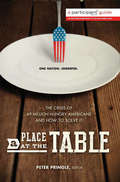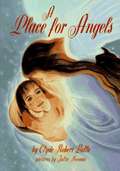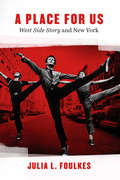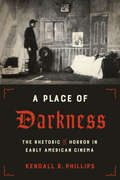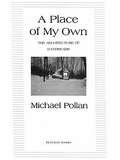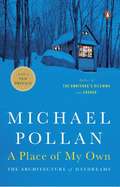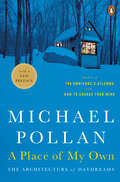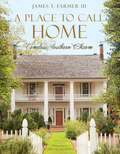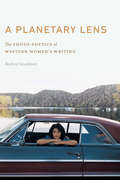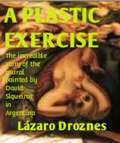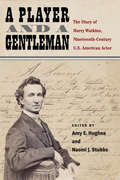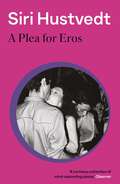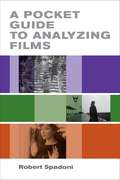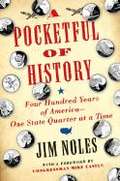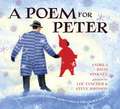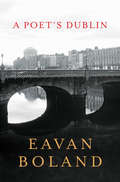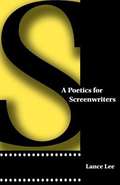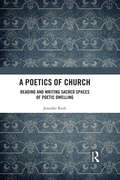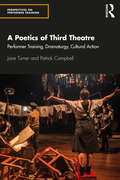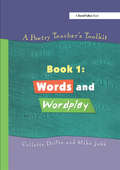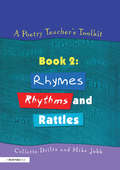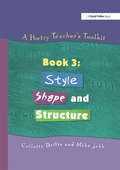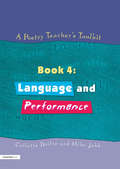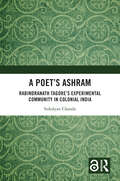- Table View
- List View
A Place at the Table: The Crisis of 49 Million Hungry Americans and How to Solve It
by Peter Pringle Participant MediaForty-nine million people#151;including one in four children#151;go hungry in the U. S. every day, despite our having the means to provide nutritious, affordable food for all. Inspired by the acclaimed documentaryA Place at the Table, this companion book offers powerful insights from those at the front lines of solving hunger in America, including: Jeff Bridges, Academy Award#150;winning actor, cofounder of the End Hunger Network, and spokesperson for the No Kid Hungry Campaign, on raising awareness about hunger Ken Cook, president of Environmental Working Group, unravels the inequities in the Farm Bill and shows how they affect America’s hunger crisis Marion Nestle, nutritionist and acclaimed critic of the food industry, whose latest work tracks the explosion of calories in today’s #147;Eat More” environment Bill Shore, Joel Berg, and Robert Egger, widely-published anti-hunger activists, suggest bold and diverse strategies for solving the crisis Janet Poppendieck, sociologist, bestselling author, and well-known historian of poverty and hunger in America, argues the case for school lunch reform Jennifer Harris, of Yale University’s Rudd Center for Food Policy and Obesity, uncovers the new hidden persuaders of web food advertisers David Beckmann, head of Bread for the World, andSarah Newman, researcher onA Place at the Table, explore the intersection of faith and feeding the hungry Mariana Chilton, Philadelphia pediatrician and anti-hunger activist, tells the moving story of her extraordinary lobby group, Witnesses to Hunger Tom Colicchio, chef and executive producer of television’sTop Chef, presents his down-to-earth case to Washington for increases in child nutrition programs Andy Fisher, veteran activist in community food projects, argues persuasively why we have to move beyond the charity-based emergency feeding program Kelly Meyer, cofounder of Teaching Gardens, illuminates the path to educating, and providing healthy food for, all children Kristi Jacobson and Lori Silverbush, the film’s directors/producers, tell their personal stories of how and why they came to make the documentary Hunger and food insecurity pose a deep threat to our nation. A Place at the Tableshows they can be solved once and for all, if the American public decides#151;as they have in the past#151;that making healthy food available, and affordable, is in the best interest of us all.
A Place for Angels
by Clyde Robert BullaClaudine's father creates an angel that looks like her dead mother and then a series of angel sculptures that take on a special significance for her when she goes to live with her aunt after her father's death.
A Place for Us: “West Side Story” and New York
by Julia L. FoulkesFrom its Broadway debut to the Oscar-winning film to countless amateur productions, West Side Story is nothing less than an American touchstone--an updating of Shakespeare vividly realized in a rapidly changing postwar New York. That vision of postwar New York is at the heart of Julia L. Foulkes's A Place for Us. A lifelong fan of the show, Foulkes became interested in its history when she made an unexpected discovery: scenes for the iconic film version were shot on the demolition site destined to become part of the Lincoln Center redevelopment area--a crowning jewel of postwar urban renewal. Foulkes interweaves the story of the creation of the musical and film with the remaking of the Upper West Side and the larger tale of New York's postwar aspirations. Making unprecedented use of director and choreographer Jerome Robbins's revelatory papers, she shows the crucial role played by the political commitments of Robbins and his fellow gay, Jewish collaborators, Leonard Bernstein and Arthur Laurents. Their determination to evoke life in New York as it was actually lived helped give West Side Story its unshakable sense of place even as it put forward a vision of a new, vigorous, determinedly multicultural American city. Beautifully written and full of surprises for even the most dedicated West Side Story fan, A Place for Us is a revelatory new exploration of an American classic.
A Place of Darkness: The Rhetoric of Horror in Early American Cinema
by Kendall R. Phillips&“An illuminating history . . . it&’s clear that the right story can still terrify us; A Place of Darkness is a primer on how the movies learned to do it.&” —NPR Horror is one of the most enduringly popular genres in cinema. The term &“horror film&” was coined in 1931 between the premiere of Dracula and the release of Frankenstein, but monsters, ghosts, demons, and supernatural and horrific themes have been popular with American audiences since the emergence of novelty cinematographic attractions in the late 1890s. A Place of Darkness illuminates the prehistory of the horror genre by tracing the way horrific elements and stories were portrayed in films prior to the introduction of the term &“horror film.&” Using a rhetorical approach that examines not only early films but also the promotional materials for them and critical responses to them, Kendall R. Phillips argues that the portrayal of horrific elements was enmeshed in broader social tensions around the emergence of American identity and, in turn, American cinema. He shows how early cinema linked monsters, ghosts, witches, and magicians with Old World superstitions and beliefs, in contrast to an American way of thinking that was pragmatic, reasonable, scientific, and progressive. Throughout the teens and twenties, Phillips finds, supernatural elements were almost always explained away as some hysterical mistake, humorous prank, or nefarious plot. The Great Depression of the 1930s, however, constituted a substantial upheaval in the system of American certainty and opened a space for the reemergence of Old-World gothic within American popular discourse in the form of the horror genre, which has terrified and thrilled fans ever since. &“[A] fascinating read.&” —Sublime Horror
A Place of Darkness: The Rhetoric of Horror in Early American Cinema
by Kendall R. Phillips&“An illuminating history . . . it&’s clear that the right story can still terrify us; A Place of Darkness is a primer on how the movies learned to do it.&” —NPR Horror is one of the most enduringly popular genres in cinema. The term &“horror film&” was coined in 1931 between the premiere of Dracula and the release of Frankenstein, but monsters, ghosts, demons, and supernatural and horrific themes have been popular with American audiences since the emergence of novelty cinematographic attractions in the late 1890s. A Place of Darkness illuminates the prehistory of the horror genre by tracing the way horrific elements and stories were portrayed in films prior to the introduction of the term &“horror film.&” Using a rhetorical approach that examines not only early films but also the promotional materials for them and critical responses to them, Kendall R. Phillips argues that the portrayal of horrific elements was enmeshed in broader social tensions around the emergence of American identity and, in turn, American cinema. He shows how early cinema linked monsters, ghosts, witches, and magicians with Old World superstitions and beliefs, in contrast to an American way of thinking that was pragmatic, reasonable, scientific, and progressive. Throughout the teens and twenties, Phillips finds, supernatural elements were almost always explained away as some hysterical mistake, humorous prank, or nefarious plot. The Great Depression of the 1930s, however, constituted a substantial upheaval in the system of American certainty and opened a space for the reemergence of Old-World gothic within American popular discourse in the form of the horror genre, which has terrified and thrilled fans ever since. &“[A] fascinating read.&” —Sublime Horror
A Place of My Own
by Michael PollanMichael Pollan's unmatched ability to draw lines of connection between our everyday experiences--whether eating, gardening, or building--and the natural world has been the basis for the popular success of his many works of nonfiction, including the genre-defining bestsellers The Omnivore's Dilemma and In Defense of Food. With this updated edition of his earlier book A Place of My Own, readers can revisit the inspired, intelligent, and often hilarious story of Pollan's realization of a room of his own--a small, wooden hut, his "shelter for daydreams"--built with his admittedly unhandy hands. Inspired by both Thoreau and Mr. Blandings, A Place of My Own not only works to convey the history and meaning of all human building, it also marks the connections between our bodies, our minds, and the natural world. Coming from The Penguin Press in 2013, Michael Pollan’s newest book Cooked: A Natural History of Transformation--the story of our most trusted food expert’s culinary education .
A Place of My Own: The Architecture of Daydreams
by Michael PollanMichael Pollan's unmatched ability to draw lines of connection between our everyday experiences- whether eating, gardening, or building-and the natural world has been the basis for the popular success of his many works of nonfiction, including the genre-defining bestsellers The Omnivore's Dilemma and In Defense of Food. With this updated edition of his earlier book A Place of My Own, readers can revisit the inspired, intelligent, and often hilarious story of Pollan's realization of a room of his own-a small, wooden hut, his "shelter for daydreams"-built with his admittedly unhandy hands. Inspired by both Thoreau and Mr. Blandings, A Place of My Own not only works to convey the history and meaning of all human building, it also marks the connections between our bodies, our minds, and the natural world.
A Place of My Own: The Education of an Amateur Builder
by Michael PollanAt a turning point in his life, writer Michael Pollan found himself dreaming of a small wood-frame hut in the woods near his house--a place to work, but also a "shelter for daydreams." Weaving the practical with the philosophical, this book presents a captivating personal inquiry into the art of architecture, the craft of building, and the meaning of modern work. Line drawings throughout. Size C. 320 pp. National ads & publicity. 35,000 print.
A Place to Call Home: Timeless Southern Charm
by James T. Farmer IIIThe acclaimed interior designer combines rich tradition with modern sensibilities in this beautifully photographed book of homes across the deep South. James Farmer&’s design firm works with clients across the South who want to turn their houses into homes. Now Farmer takes readers on a guided tour of eleven home projects—from makeovers to remodels and new construction—as he brings together a cultivated mix of high and low, storied and new, collected and found; presenting them all as a thoughtfully exhibited array of taste, style, good architecture, and interior comfort. Woven alongside beautiful photography of interiors and exteriors are personal stories James shares about living in the South, the people in his life, and how he fell in love with home design. A Place to Call Home is a beautiful book to inspire Southern style at home―infusing the new with antique, vintage, and heirloom pieces.
A Planetary Lens: The Photo-Poetics of Western Women's Writing (Postwestern Horizons)
by Audrey GoodmanA Planetary Lens delves into the history of the photo-book, the materiality of the photographic image on the page, and the cultural significance of landscape to reassess the value of print, to locate the sites where stories resonate, and to listen to western women&’s voices. From foundational California photographers Anne Brigman and Alma Lavenson to contemporary Native poets and writers Leslie Marmon Silko and Joy Harjo, women artists have used photographs to generate stories and to map routes across time and place. A Planetary Lens illuminates the richness and theoretical sophistication of such composite texts. Looking beyond the ideologies of wilderness, migration, and progress that have shaped settler and popular conceptions of the region, A Planetary Lens shows how many artists gather and assemble images and texts to reimagine landscape, identity, and history in the U.S. West. Based on extensive research into the production, publication, and circulation of women&’s photo-texts, A Planetary Lens offers a fresh perspective on the entangled and gendered histories of western American photography and literature and new models for envisioning regional relations.
A Plastic Exercise
by Lázaro Droznes Linda Buenfil CantoThis work of fiction recreates the days of the year 1932 in which, David Siqueiros, a painter committed with communism and art as an instrument of the Revolution, agrees to paint a mural illustrating nude women in the basement of in the country house known as Los Granados, which belonged to the newspaper mogul Natalio Botana, owner of the Crítica, against all his ideological principles. The wife of the painter, Blanca Luz Brum, is the model used in the mural. once the project is over, Blanca leaves Siqueiros and falls in love with Natalio Botana. Siqueiros returns to Mexico deported from Argentina and a year later Luz abandons Botana. Fifty years later the property is bought to extract the mural from the abandoned basement and sell it in the international market. As a consequence of legal problems the art piece is held for 15 years at various warehouses in the Puerto de Buenos Aires and finally is expropriated by the Argentinian Government to be restored and exhibited to the public during the celebration of the Bicentennial of the Independence of Argentina. This fiction recreates the situations that accompanied this extraordinary story which reflects Argentina in the 1930's and the round of couples that was its leitmotiv.
A Player and a Gentleman: The Diary of Harry Watkins, Nineteenth-Century U.S. American Actor
by Amy E Hughes Naomi J StubbsHardworking actor, playwright, and stage manager Harry Watkins (1825–94) was also a prolific diarist. For fifteen years Watkins regularly recorded the plays he saw, the roles he performed, the books he read, and his impressions of current events. Performing across the U.S., Watkins collaborated with preeminent performers and producers, recording his successes and failures as well as his encounters with celebrities such as P. T. Barnum, Junius Brutus Booth, Edwin Forrest, Anna Cora Mowatt, and Lucy Stone. His is the only known diary of substantial length and scope written by a U.S. actor before the Civil War—making Watkins, essentially, the antebellum equivalent of Samuel Pepys. Theater historians Amy E. Hughes and Naomi J. Stubbs have selected, edited, and annotated excerpts from the diary in an edition that offers a vivid glimpse of how ordinary people like Watkins lived, loved, struggled, and triumphed during one of the most tumultuous periods in U.S. history. The selections in A Player and a Gentleman are drawn from a more expansive digital archive of the complete diary. The book, like its digital counterpart, will richly enhance our knowledge of antebellum theater culture and daily life in the U.S. during this period.
A Plea For Eros
by Siri HustvedtA stunning collection of essays by the author of WHAT I LOVED, in which she addresses many of the themes explored in her novels - identity, sexual attraction, relationships, family, mental illness, the power of the imagination, a sense of belonging and mortality. In three cases, she focuses on the novels of other writers - Dickens, James and Fitzgerald. She also refers to her own novels, affording an unusual insight into their creation. Whatever her topic, her approach is unaffected, intimate and conversational, inviting us both to share her thoughts and reflect on our own views and ideas.
A Pocket Guide to Analyzing Films
by Robert SpadoniThe perfect concise guide to the formal analysis of film. Designed to be used by readers at many levels of knowledge, this book moves systematically through the elements that make up most films, focusing on aspects of the art of cinema that are common across history and national cinemas. From form and narrative to mise-en-scène and cinematography to editing and sound, Robert Spadoni introduces and explains the principles and conventions of film in engaging, straightforward language. In addition to illustrating film techniques with almost 200 images--most of them in color--the book explains ways to find patterns and meaning in films through such concepts as motifs, development, and motivation. Thumbnail readings of exemplary films further lay out the essentials of formal analysis. Film illustrations include frame enlargements from Stagecoach, Psycho, Jeepers Creepers, Persepolis, Groundhog Day, Take Shelter, and more. Modestly priced and packed with images, A Pocket Guide to Analyzing Films is ideal for students in a wide range of film courses who are looking for an easy-to-read guide to film analysis to accompany and enhance their course materials.
A Pocketful of History: Four Hundred Years of America One State Quarter at a Time
by Jim NolesA HISTORY-RICH LOOK at the coins in your pocket-the fifty state quarters-and what they tell us about "changing" America Our past is all around us-even in the spare change jangling in your purse or pocket. For the past decade, the United States Mint has offered America a pocketful of history through its popular 50 State Quarters® Program. When the final quarters are released, thousands of us will have collected these commemorative coins, one for each state and territory in the Union. But what can we learn about our country's stories and lore from a mere $12.50 in state quarters? Jim Noles's fascinating book, A Pocketful of History, looks at each quarter in turn to answer these curious questions . . . * Who is Caesar Rodney and why is he riding a horse on Delaware's quarter? * What is the real history behind Abraham Lincoln's political career in his home state Illinois? * What happened to New Hampshire's symbol, the "Old Man in the Mountain," three years after its quarter was minted? * What famous racecourse is memorialized on the quarter from the state known as the "Crossroads of America"? Congress recently extended the program to include six additional quarters for Washington, D.C., and the affiliated territories of the United States, to be released in 2009. Why is Pennsylvania known a the Keystone State? Why did California choose to honor preservationist John Muir rather than a mining '49er? . . . and many, many more. A Pocketful of History tells the story behind each state's quarter-how each state chose its design; what is important about the people, scenes, and themes depicted on the coins; and what the collection tells us about ourselves. It's an entertaining and enlightening journey through four hundred years of America in twenty-five-cent doses.
A Poem for Peter: The Story of Ezra Jack Keats and the Creation of The Snowy Day
by Rosemary Wells Andrea Davis Pinkney Steve Johnson Lou Fancher<p>A celebration of the extraordinary life of Ezra Jack Keats, creator of The Snowy Day. <p>The story of The Snowy Day begins more than one hundred years ago, when Ezra Jack Keats was born in Brooklyn, N.Y. The family were struggling Polish immigrants, and despite Keats's obvious talent, his father worried that Ezra's dream of being an artist was an unrealistic one. But Ezra was determined. By high school he was winning prizes and scholarships. Later, jobs followed with the WPA and Marvel comics. But it was many years before Keats's greatest dream was realized and he had the opportunity to write and illustrate his own book. <p>For more than two decades, Ezra had kept pinned to his wall a series of photographs of an adorable African American child. In Keats's hands, the boy morphed into Peter, a boy in a red snowsuit, out enjoying the pristine snow; the book became The Snowy Day, winner of the Caldecott Medal, the first mainstream book to feature an African American child. It was also the first of many books featuring Peter and the children of his -- and Keats's -- neighborhood. <p>Andrea Davis Pinkney's lyrical narrative tells the inspiring story of a boy who pursued a dream, and who, in turn, inspired generations of other dreamers.</p>
A Poet's Dublin
by Eavan BolandJuxtaposing verse and image, A Poet's Dublin is a study of origin and influence from "a major Irish poet" (Edward Hirsch). Written over years, the transcendent and moving poems in A Poet's Dublin seek out shadows and impressions of a powerful, historic city, studying how it forms and alters language, memory, and selfhood. The poems range from an evocation of the neighborhoods under the hills where the poet lived and raised her children to the inner-city bombing of 1974, and include such signature poems as "The Pomegranate," "The War Horse," and "Anna Liffey." Above all, these poems weave together the story of a self and a city--private, political, and bound by history. The poems are supported by photographs of the city at all times and in all seasons: from dawn on the river Liffey, which flows through Dublin, to twilight up in the Dublin foothills.
A Poetics for Screenwriters
by Lance LeeWriting successful screenplays that capture the public imagination and richly reward the screenwriter requires more than simply following the formulas prescribed by the dozens of screenwriting manuals currently in print. Learning the "how-tos" is important, but understanding the dramatic elements that make up a good screenplay is equally crucial for writing a memorable movie. In A Poetics for Screenwriters, veteran writer and teacher Lance Lee offers aspiring and professional screenwriters a thorough overview of all the dramatic elements of screenplays, unbiased toward any particular screenwriting method.<P><P> Lee explores each aspect of screenwriting in detail. He covers primary plot elements, dramatic reality, storytelling stance and plot types, character, mind in drama, spectacle and other elements, and developing and filming the story. Relevant examples from dozens of American and foreign films, including Rear Window, Blue, Witness, The Usual Suspects, Virgin Spring, Fanny and Alexander, The Godfather, and On the Waterfront, as well as from dramas ranging from the Greek tragedies to the plays of Shakespeare and Ibsen, illustrate all of his points.<P> This new overview of the dramatic art provides a highly useful update for all students and professionals who have tried to adapt the principles of Aristotle's Poetics to the needs of modern screenwriting. By explaining "why" good screenplays work, this book is the indispensable companion for all the "how-to" guides.
A Poetics of Church: Reading and Writing Sacred Spaces of Poetic Dwelling
by Jennifer ReekThis innovative book aims to create a ‘poetics of Church’ and a ‘religious imaginary’ as alternatives to more institutional and conventional ways of thinking and of being ‘Church’. Structured as a spiritual and literary journey, the work moves from models of the institutional Catholic Church into more radical and ambiguous textual spaces, which the author creates by bringing together an unorthodox group of thinkers referred to as ‘poet-companions’: the 16th-century founder of the Society of Jesus, Ignatius of Loyola, the French thinkers Gaston Bachelard and Hélène Cixous, the French poet Yves Bonnefoy, and the English playwright Dennis Potter. Inspired especially by the reading and writing practices of Cixous, the author attempts to exemplify Cixous’ notion of écriture féminine—‘feminine writing’—that suggests new ways of seeing and relating. The project’s uniting of Ignatian spirituality with postmodern thinking and its concern with creating new theological, literary and spiritual spaces for women both coincide and contrast with Pope Francis’s pastoral and reformist tendencies, which have neglected to adequately address the marginalisation of women in the Church. As Francis has called for ‘a theology of women’, of which there are, of course, many to draw from, this volume will be a timely contribution with a unique interdisciplinary approach.
A Poetics of Third Theatre: Performer Training, Dramaturgy, Cultural Action (Perspectives on Performer Training)
by Patrick Campbell Jane TurnerA Poetics of Third Theatre offers an in-depth, critical analysis of Third Theatre, a transnational community of theatre groups and artists united by a shared set of values and a laboratory attitude. This book takes a genealogical account of Third Theatre as a concept and a practice that draws attention to the historical Third Theatre Encounters that have taken place across Europe and Latin America since the 1970s. The work of renowned Third Theatre groups and organisations, such as LUME (Brazil), Grupo Cultural Yuyachkani (Peru), Triangle Theatre (UK) and Nordisk Teaterlaboratorium – NTL (Denmark), are explored to reveal how a multifarious poetics of Third Theatre is manifest through these artists’ approaches to performer training, dramaturgy and cultural action. Three critical pillars – unconditional hospitality, artisanal craft and (re)enchantment – are employed in order to illuminate the shared ethos of the Third Theatre community and its exemplification as a mode of cultural performance. This informative text will be of great use to students and scholars of drama and theatre studies, and its dedicated section on performer training exercises offers the reader pathways into an experiential engagement with Third Theatre craft.
A Poetry Teacher's Toolkit: Book 1: Words and Wordplay
by Collette Drifte Mike JubbProfessional poets spend many hours crafting a finished piece of work, yet we expect children in school to sit down and write when they are told to, whether they feel inspired or not. This series of four books is a toolkit to help you build a positive framework for children to read, write, understand and enjoy poetry - to bring a creative spark to the poetry classroom. A combination of featured poems, creative ideas, structured lesson plans and differentiated photocopiable activity sheets gives the series a uniquely flexible approach - which means you can use the materials in any classroom context. If you're wary of poetry, if you think it's boring, or if you're nervous about teaching poetry, then you've chosen the right book. Key themes covered in BOOK 1: Words and Wordplay are playing with words; making patterns with words; words and meanings; puns and puzzles; how words affect readers; moods, feelings and attitudes; and how poets manipulate words. Other books in the series are: BOOK 2: Rhymes, Rhythms and Rattles; BOOK 3: Style, Shape and Structure; and BOOK 4: Language and Performance.
A Poetry Teacher's Toolkit: Book 2: Rhymes, Rhythms and Rattles
by Collette Drifte Mike JubbProfessional poets spend many hours crafting a finished piece of work, yet we expect children in school to sit down and write when they are told to, whether they feel inspired or not. This series of four books is a toolkit to help you build a positive framework for children to read, write, understand and enjoy poetry - to bring a creative spark to the poetry classroom. A combination of featured poems, creative ideas, structured lesson plans and differentiated photocopiable activity sheets gives the series a uniquely flexible approach - which means you can use the materials in any classroom context. If you're wary of poetry, if you think it's boring, or if you're nervous about teaching poetry, then you've chosen the right book. Key themes covered in BOOK 2: Rhymes, Rhythms and Rattles are rhythm and rhyme in poetry, sounds, alliteration, words to create effects, onomatopoeia, and metaphor and simile. Other books in the series are: BOOK 1: Words and Wordplay; BOOK 3: Style, Shape and Structure; and BOOK 4: Language and Performance.
A Poetry Teacher's Toolkit: Book 3: Style, Shape and Structure
by Collette Drifte Mike JubbProfessional poets spend many hours crafting a finished piece of work, yet we expect children in school to sit down and write when they are told to, whether they feel inspired or not. This series of four books is a toolkit to help you build a positive framework for children to read, write, understand and enjoy poetry - to bring a creative spark to the poetry classroom. A combination of featured poems, creative ideas, structured lesson plans and differentiated photocopiable activity sheets gives the series a uniquely flexible approach - which means you can use the materials in any classroom context. If you're wary of poetry, if you think it's boring, or if you're nervous about teaching poetry, then you've chosen the right book. Key themes covered in BOOK 3: Style, Shape and Structure are style and structure, addressing regular and standard forms, the impact of layout, free form, 'found' poetry, and concrete poetry. Other books in the series are: BOOK 1: Words and Wordplay; BOOK 2: Rhymes, Rhythms and Rattles; and BOOK 4: Language and Performance.
A Poetry Teacher's Toolkit: Book 4: Language and Performance
by Collette Drifte Mike JubbProfessional poets spend many hours crafting a finished piece of work, yet we expect children in school to sit down and write when they are told to, whether they feel inspired or not. This series of four books is a toolkit to help you build a positive framework for children to read, write, understand and enjoy poetry - to bring a creative spark to the poetry classroom. A combination of featured poems, creative ideas, structured lesson plans and differentiated photocopiable activity sheets gives the series a uniquely flexible approach - which means you can use the materials in any classroom context. If you're wary of poetry, if you think it's boring, or if you're nervous about teaching poetry, then you've chosen the right book. Key themes covered in BOOK 4: Language and Performance are moods and feelings through the use of effective language; nonsense and humorous verse; the continuity and links between ancient and modern, between nursery and playground rhymes and Shakespeare; whatever our ability, there is a place for everyone on the poetry 'ladder'; and performance poetry. Other books in the series are: BOOK 1: Words and Wordplay; BOOK 2: Rhymes, Rhythms and Rattles; and BOOK 3: Style, Shape and Structure.
A Poet’s Ashram: Rabindranath Tagore’s Experimental Community in Colonial India
by Sukalyan ChandaThe remarkably creative life Rabindranath Tagore (1861–1941) lived has long been an area of scholarly enquiry. Yet, surprisingly, his role as the founder of an experimental ashram community remains unexplored. A Poet’s Ashram retrieves his idea of his ashram through an exploration of his writings on the institutions he built.The ashram community Tagore endeavoured to create in Santiniketan during the period 1901–1941 was his response to the question of modernity. Through his effort to reinvent the ancient Indian ideal of the ashram, he articulated his idea of a mode of collective living that was meant to be grounded in a set of ethical values derived from India’s civilizational inheritance. This book traces the history of how his ashram school evolved into a community that practised egalitarianism, inclusiveness and creativity through its daily existence. It explores a range of nineteenth- and twentieth-century discourses and Tagore’s engagement with them in order to situate that idea within its historical context, a critical juncture in the history of modern India and the world. This book’s reading of his project unravels its anti-colonial underpinnings and the commonalities it shared with some of the other similar experimental communities that challenged illiberal ideologies and power relations during the early twentieth century.Meticulously researched and perceptively written, this book will be of interest to students and researchers of history, political science, culture studies and postcolonial studies. It will also be of interest to educationists, educators and those interested in colonial modernity, modern Indian history, philosophy of education, institution building, peace, inclusivity and sustainability.
